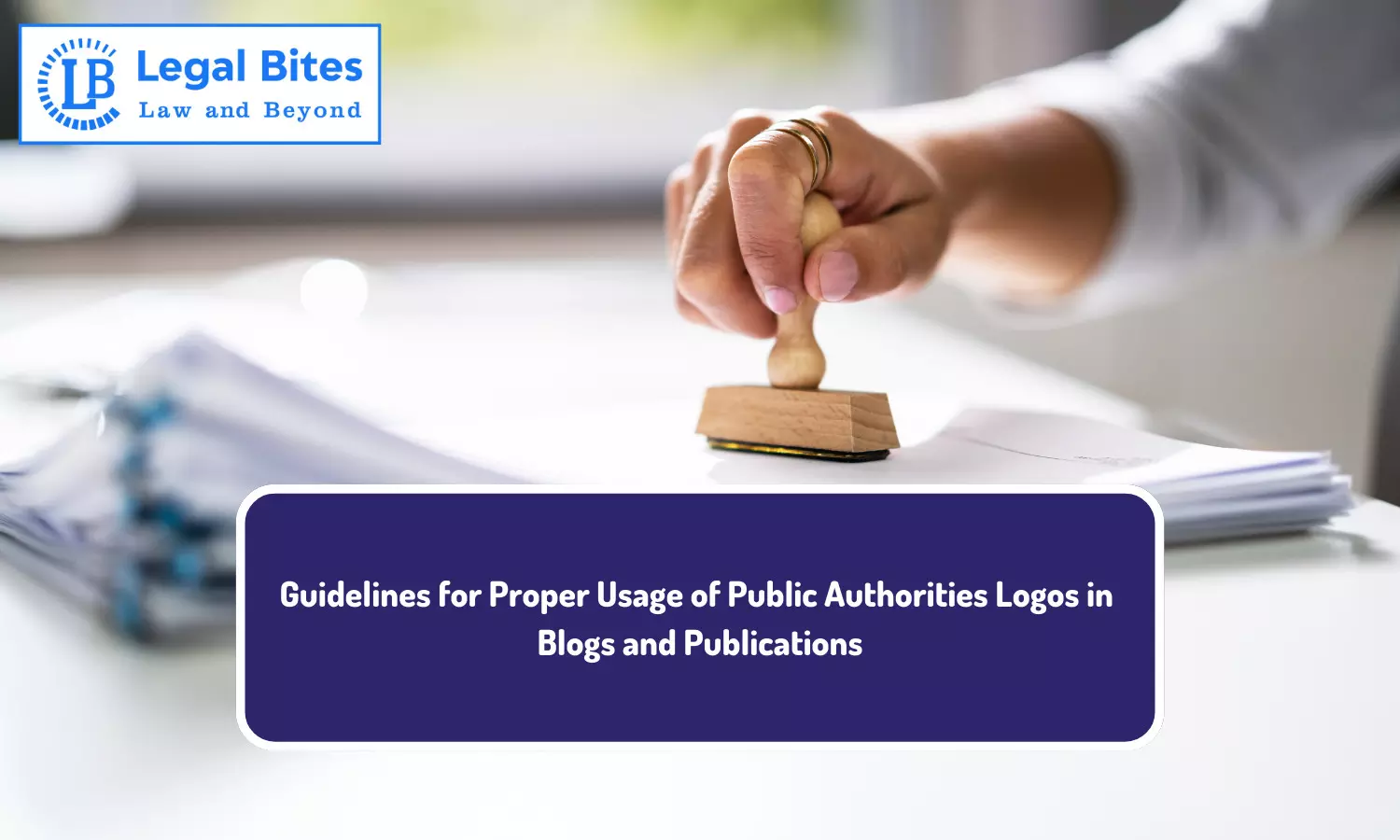Guidelines for Proper Usage of Public Authorities Logos in Blogs and Publications
This article intends to highlight the issues pertaining to the usage of emblems and government logos, which have been highlighted in recent times.

The article 'Guidelines for Proper Usage of Public Authorities Logos in Blogs and Publications' intends to highlight the issues about the usage of emblems and government logos, which have been highlighted in recent times and legislative background about the same.
The National Emblem or Logos of Government Departments is a seal which is utilized for earmarking official purposes and ensuring the highest admiration. For general people, it is a symbol of integrity and also depicts the strong foundation of constitutional values. However, with the advent of technology, governing the usage of such emblems and logos has been a tough task whether it be authorities/commissions, government agencies or ministries.
Introduction
A national emblem or official logos provides a sense of authority and there have been numerous instances in recent times wherein, the national emblem or official logos have been misused by blogs, websites, apps etc., for using such sense of authority for committing fraud and taking undue advantage out of the same. The common people often come under the impression that such blogs, websites, apps etc. are official apps from the government and ended up falling into this trap.
No wonder, hundreds of blogs and websites are blatantly misusing the Indian emblem and official logos by misusing the same and earning money through false advertisements, promotions, brochures, flyers, and handouts. With drastic technological advancement in the last decade, government logos have been blatantly used by inscribing the same over the documents, to make the claim that such documents are genuine common people are misled and they end up falling prey to such misapplication of emblems and State symbols.
The issue of misusing emblems and logos got highlighted during the times of pandemic when the Organizations reached out to the public asking for donations, funds, and contributions for the underprivileged and poorer segments of society, which seemed admirable. However, the legitimacy of such an organization was in question, since they were using such emblems/logos and the donations never reached the intended recipients.
This brings us to the question that do we have any legislative framework for dealing with such situations.
Legislative Framework
The State Emblem of India (Prohibition of Improper Use) Act, 2005 and the Emblems & Names (Prevention of Improper Use) Act, 1950 are the leading legislative frameworks dealing with the usage of emblems and Section 7 of the State Emblem of India (Prohibition of Improper Use) Act, 2005 provides penalty for using the emblem or any imitation in such a manner that portrays an impression that the same is associated with or an official document of the Central Government or State Government, as the case may be, without being authorized by the appropriate government.
The legislative frameworks specifically prohibit the use of emblem for commercial extraction or as a part of trademark or design except in those cases which are specified by the Central Government and any registration of intellectual property which contains the Emblem is strictly prohibited.
Loopholes in Existing Legislation
Those persons who are thereby mentioned in Schedule I, II and III of the State Emblem of India (Regulation of Use) Rules, 2007 can use the National Emblem. Thus a strict restriction has been imposed on the usage of the emblem by persons. Prior approval from the Central Government is needed if the same has to be used by Rule 11 of the State Emblem of India (Regulation of Use) Rules, 2007.
Provisions of the State Emblem of India (Prohibition of Improper Use) Act, 2005 prohibit misuse or unauthorized usage of the emblems along with certain names. While Section 3 talks about the improper use of emblems, Section 4 talks about the use of emblems for any trade, business, calling or profession or in the title of any patent, or any trade mark or design. It is also noteworthy to mention the presence of the Emblems & Names (Prevention of Improper Use) Act, 1950 which also mentions provisions on similar grounds. It is, however, imperative to note that the mere existence of these laws does not create the deterrence of improper usage as has been aimed via these legislations.
Lack of Strictness leads to misuse in blogs/ publications-
It is required for NGOs, for instance, to take due course of permission from the Central Government before using the national emblem on their websites through which they advertise the causes that they are contributing to. Quoting this example is important because NGOs often seek large-scale donations from the public and to protect their authenticity often falsely project their association with the government or any public authority. The lack of permission or adherence to the above-mentioned provisions leads to improper usage of the same by such NGOs and even other bodies of associations and groups of people to lure the public into believing that they are an authentic source. Through this, they can monetize their false agendas and thus the laws remain of hardly any validity.
The need that can thus be streamlined from this is that there is a necessity for due guidelines that regulate such usage of public authorities’ logos in blogs and publications to restrict and prohibit false claims. Moreover, it is essential to eliminate any false associations and further for the government to completely disassociate from such unscrupulous players who portray untrue claims on their blogs and websites.
DIPP (Department of Industrial Policy and Promotion) lays down norms on the use of the 'Make in India' logo
In light of the above discussion where we understood how misuse of logos for instance the national emblem leads to ambiguity with regards to the user’s authenticity, let us now discuss the ‘Make in India’ Campaign’s logo that has been attempted to be duly protected from any such unscrupulous use.
A proper procedure has been laid down by the Indian Government to take permission for using the ‘MII-Logo’:
1. Merit-based scrutiny is to be conducted by the DIPP from all the applications that it would receive for seeking permission about usage of the MII Logo. The same shall then have to be approved by the Secretary/ Joint Secretary of DPIIT (Department of Promotion of Industry and Internal Trade).
2. Further, DIPP has the right to demand more additional and relevant information to scrutinize the application in more depth if it deems fit to do so.
3. Request for usage of the MII Logo in electronic media has to be sent 30 days in advance, before the intended use. Such application has to accompany the following perquisites as well:
a. Nature of the Program.
b. Profile or track record of producers of the game.
c. The target audience.
d. The contents of the program and specifically, the inclusion of manufacturing-related content of the program
Conclusion
As understood, before any intended use of a government department’s logo, due permission has to be taken by the Central Government, post which it shall be considered valid to use the same. A proposal has to be submitted for the government to verify and authenticate any such usage. The need for transparency in the government’s association and engagement with any company on its blog or other such publications is utterly necessary to gauge any misinformation that might be spread through their means by way of attaching the government’s name.
This public-private partnership needs to be regulated with stricter guidelines and regulatory bodies to provide for a mechanism that is robust and thereby prevents the spread of any misinformation by such false associations and improper usage of National Emblem or Logos of Government Departments.
References
[1] Make disclaimers a must for using government logos: Experts, Available Here
[2] Know how to use the ‘Make in India’ logo, Available Here
[3] The Use and Misuse of Emblems and State Symbols, Available Here

